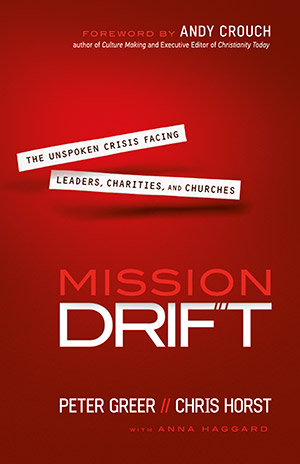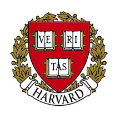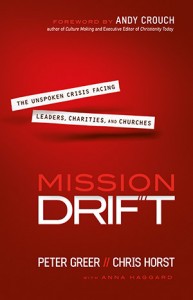
Mission Drift – A Book Review
May 12, 2015“Mission Drift” – Peter Greer & Christ Horst
The Unspoken Crisis Facing Leaders, Charities, and Churches
No newcomers to the non-profit arena, HOPE International’s Peter Greer and Chris Horst supply not just a resource for those navigating the world of charity and church, but the guide for organizations and their leaders looking to enter and remain aligned with the ‘narrow gate’ that is mission authenticity. As the writers point out, the difference between being mission true and succumbing to drift can be gradual, subtle, and even precarious.
Greer, Horst and Haggard not only offer personal experience but thorough research in Mission Drift, tracking, measuring and surveying the fates of countless mission true and mission untrue organizations. Citing examples from Yale University to Compassion International, this exhaustive and pinpoint account of a very real problem in faith-centered circles should find itself in every non-profit’s library, if not within their employee manual.
Grade – A
The Prototype for Drift – The Ivy League Deviators ⊕

As America’s oldest institution (established in 1636) of higher learning, prestigious Harvard University is usually associated with academic grandeur and the sharpest students and staff the world has to offer, yet nothing about Harvard in 2015 resembles a devotion to any particular religion or faith. In fact, this “objectivity” has become a bit of a hallmark for not just Harvard, but many colleges and universities across the nation. But was this brand of objectivity what its founder, John Harvard, had in mind? The fact is the only remnant of Harvard’s original mission still intact today is its shield which bears the Latin “Veritas,” meaning “truth.” Well, partially. The original Harvard seal read: “Veritas – Christo et Ecclesiae,” or Truth for Christ and the Church. Many of Harvard’s attendees, alumnae and donors may be surprised to know that the “truth” positioned at the center of its famous emblem was originally intended to point to the person of Jesus, not to the craft of the classroom. Below is a portion of Harvard’s original mission statement which is clearly and unashamedly Christian.
“Let every Student be plainly instructed, and earnestly pressed to consider well, the maine end of his life and studies is, to know God and Jesus Christ which is eternal life (John 17:3) and therefore to lay Christ in the bottome, as the only foundation of all sound knowledge and Learning. And seeing the Lord only giveth wisedome, Let every one seriously set himself by prayer in secret to seeke it of him (Prov. 2:3).”
Suffering an almost identical mission-straying fate as Harvard was its Ivy League Counterpart, Yale University, whose original motto was “light and truth.” Interestingly enough, Yale’s inception was largely due to Harvard’s slow removal of the Gospel of Jesus from its institutional vision. Reacting to Harvard’s missional decline, Elihu Yale endeavored to found a college (1718) that would stay true to its biblical roots. Yet nearly 300 years later, its exclusively scholastic and extremely mission untrue statement reads: to create, preserve, and disseminate knowledge.
The steady deviation from original mission to something else entirely, characterized by these Ivy League schools and others, according to Mission Drift, are prototypical case studies for Christ-focused non-profits, churches and charity organizations wanting to avoid a similar demise.
Safeguarding truth, not tradition ⊕
A common advantage of mission true organizations, according to Greer and Horst, is the prevalence of safeguards put in place to protect the mission. Such safeguards could range from staff specifically appointed to guard the focused mission of the organization, like in the case of Compassion International, to a Board of Directors charter drafted and enacted to either ensure the original mission or simply cease to exist, as is the case with Edify. The authors do imply, however, that these safeguards and steps are not protecting tradition per se, but rather truth and intention. The book provides a few examples of this distinction. Young Life and Cru are longstanding evangelical organizations with the shared mission of reaching young people with the Gospel. If, to this day, they’d remained true to their organization’s traditions their very existence could quite possibly be in jeopardy. Both groups have evolved and changed while remaining devout to their mission. Young Life has adapted over the years to best impact young people. Originally fashioned to reach teenagers through the appeal of barbershop quartets, Young Life today has traded in its pinstripes and mustaches for social media. In the same way, Cru, originally ‘Campus Crusade for Christ,’ changed its name since it was established in the 1950’s, not to conform to political correctness but rather to share the Gospel at college campuses in a way that was most strategic. The stigma that surrounds the word ‘crusade’ is unmistakable and actually mission-deterring in today’s youth culture. Cru got rid of the deterrent in order to better accomplish its longstanding mission. I believe, as do the authors of Mission Drift, that’s what the Apostle Paul would call shrewd! These examples of changing while not compromising mission are the reason Greer concludes that “change does not equal drift.”
Identifying the primary symptom of drift – Organizational prayer life ⊕
Nearly without exception, the propensity for drift among churches, charitable organizations and non-profits can be traced in some degree to a lack of prayer and the organizational emphasis thereof. A shortcoming this simple can, in fact, decide the course of an organization’s mission orientation, but it shouldn’t be surprising. The Bible speaks to this point, that prayer is an absolute keystone in propelling the mission of the Gospel and subsequently any organization whose mission incorporates the Gospel. As one could probably guess, if the spiritual components of a faith centered organization begin to unravel, the mission itself is sure to follow suit.
Building and maintaining a God & mission-honoring team ⊕
As Greer & Co. point out a common thread among mission true organizations is the tendency to be “slow to hire and quick to fire.” A comprehensive and serious assessment of a staff team, from the Chief Financial Officer to the volunteer, is one factor that separates mission accuracy from mission deviation.  Having a mission-selective view of human resources is a mainstay for all mission true organizational cultures, and something that HOPE International espouses to as well. Not only is this highly qualitative approach necessary for the staff but also for the Board of Directors. In the chapter titled, “Guardians of the Mission,” the authors argue that perhaps no other element is as important to guarding an organization’s mission as its Board of Directors. As with most companies with a Board of Directors, all organizational goings-on are steered by the board, thus making the members seated on it integral in protecting its mission. If mission is averted, chances are the board had something to do with it, argues Mission Drift. In fact, research has shown that all mission true organizations have at some point faced difficult decisions with their staff and board, and have consequently had to sever ties with mission-threatening personnel in order to stay true to course.
Having a mission-selective view of human resources is a mainstay for all mission true organizational cultures, and something that HOPE International espouses to as well. Not only is this highly qualitative approach necessary for the staff but also for the Board of Directors. In the chapter titled, “Guardians of the Mission,” the authors argue that perhaps no other element is as important to guarding an organization’s mission as its Board of Directors. As with most companies with a Board of Directors, all organizational goings-on are steered by the board, thus making the members seated on it integral in protecting its mission. If mission is averted, chances are the board had something to do with it, argues Mission Drift. In fact, research has shown that all mission true organizations have at some point faced difficult decisions with their staff and board, and have consequently had to sever ties with mission-threatening personnel in order to stay true to course.
Can we be faithful and sinful at the same time? ⊗
There is much talk throughout Mission Drift about remaining faithful to one’s mission, both individually and corporately, with plenty of examples of those people and groups that did remain faithful to their calling. However, in the same breath the authors are willing to submit to sinfulness as inevitable and natural to a mission and the people surrounding it. In the chapter titled “Functional Atheism,” the authors describe Jesus’ ministry as a glimpse of what Heaven will be like in the distant future and liken this place of “lack” to the ministry of the church. In my view, this distinction is dangerous because it handcuffs the Holy Spirit and, to a degree, strips the Gospel of its power. In fact, most of the new testament warrants acting out of the reality that heaven is accessible here and now, and that we need not live out of place of lack anymore. An ‘underspiritual’ view of present day ministry, whether its micro-enterprise or evangelism, certainly begs the question: are all of those faithful, enduring, mission-true saints closet sinners and strivers at the same time? I don’t think so. This contradiction is a theological qualm, of course, but a very important faith-centric tenet that has the capacity to transcend mission. It’s useful when exploring what I call ‘sin consciousness,’ a variety of scriptures that set the record straight, like 1st John. 1st John 2:1 reads:
My dear children, I write this to you so that you will not sin. But if anybody does sin, we have an advocate with the Father- Jesus Christ, the Righteous One.” 1ST JOHN 2:1
There aren’t any complexities with John’s straightforward language, he plainly states in his letter that the reason he is writing is so that his friends in ministry will not sin. If they do, they have an advocate in Jesus, yes, but the message not only hints at but clearly notes the possibility of avoiding sin. Paul addresses sin this way: “For we know that our old self was crucified with him so that the body ruled by sin might be done away with, that we should no longer be slaves to sin – because anyone who has died has been set free from sin.” (ROMANS 6: 6-7) Death to self = the prospect of departing from sinfulness. That is definitely mission-worthy!
Being part of a faith-based team personally, Mission Drift has immediately become one of my favorites. It should get special attention because its authors have actually lived out “Mission Truth” as leaders of HOPE International, a Christian micro-enterprise non-profit headquartered here in Lancaster. If you or someone close to you are part of a faith-centered organization, church or charity, or you at least contribute time or money to one, pick up this book and don’t put it down until you’ve finished!
 Joe D’Orsie – Communications & Spiritual Life Counsel jdorsie@livewithpurposecoaching.com
Joe D’Orsie – Communications & Spiritual Life Counsel jdorsie@livewithpurposecoaching.com
